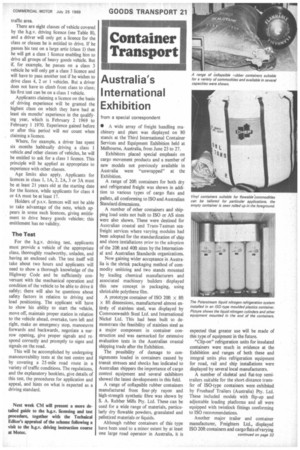Container Transport
Page 23

If you've noticed an error in this article please click here to report it so we can fix it.
Australia's International Exhibition
from a special correspondent • A wide array of freight handling machinery and plant was displayed on 80 stands at the Third International Container Services and Equipment Exhibition held at Melbourne, Australia, from June 23 to 27.
Exhibitors placed special emphasis on cargo movement products and a number of new models not previously available in Australia were "unwrapped" at the Exhibition.
A range of 20ft containers for both dry and refrigerated freight was shown in addition to various types of cargo flats and pallets, all conforming to ISO and Australian Standard dimensions.
A number of other containers and shipping load units not built to ISO or AS sizes were also shown. These were destined for Australian coastal and Trans-Tasman seafreight services where varying modules had been adopted for the standardization of ship and shore installations prior to the adoption of the 20ft and 40ft sizes by the International and Australian Standards organizations.
Now gaining wider acceptance in Australia is the shrink packaging method of commodity unitizing and two stands mounted by leading chemical manufacturers and associated machinery builders displayed this new concept in packaging, using shrinkable polythene film.
A prototype container of ISO 20ft x 8ft X 8ft dimensions, manufactured almost entirely of stainless steel, was displayed by Commonwealth Steel Ltd. and International Nickel Ltd. This had been built to demonstrate the feasibility of stainless steel as a major component in container construction and was earmarked for extensive evaluation tests in the Australian coastal shipping trade after the Exhibition.
The possibility of damage to consignments loaded in containers caused by transit stresses and shocks has indicated to Australian shippers the importance of cargo control equipment and several exhibitors showed the latest developments in this field.
A range of collapsible rubber containers manufactured from four-ply rayon and high-strength synthetic fibre was shown by S. A. Rubber Mills Pty. Ltd. These can be used for a wide range of materials, particularly dry flowable powders, granulated and pelletized materials or liquids.
Although rubber containers of this type have been used to a minor extent by at least one large road operator in Australia, it is expected that greater use will be made of this type of equipment in the future.
"Clip-on" refrigeration units for insulated containers were much in evidence at the Exhibition and ranges of both these and integral units plus refrigeration equipment for road, rail and ship installations were displayed by several local manufacturers.
A number of skeletal and flat-top semitrailers suitable for the short-distance transfer of ISO-type containers were exhibited by Fruehauf Trailers (Australia) Pty. Ltd. These included models with flip-up and adjustable loading platforms and all were equipped with twistlock fittings conforming to ISO recommendations.
Another major trailer and container manufacturer, Freighters Ltd., displayed ISO 20ft containers and cargo flats of varying
















































































































